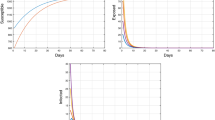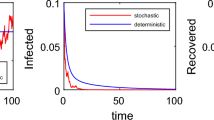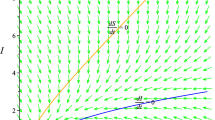Abstract
In the previous paper (Inaba in J Math Biol 65:309–348, 2012), we proposed a new (most biologically natural) definition of the basic reproduction number \(R_0\) for structured population in general time-heterogeneous environments based on the generation evolution operator. Using the mathematical definition for cone spectral radius, we show that our \(R_0\) is given by the spectral radius of the generation evolution operator in the time-state space. Then as far as we consider linear population dynamics, our \(R_0\) is a threshold value for population extinction and persistence in time-heterogeneous environments. Next we prove that even for nonlinear systems, our \(R_0\) plays a role of a threshold value for population extinction in time-heterogeneous environments. For periodic systems, we can show that supercritical condition \(R_0>1\) implies existence of positive periodic solution. Finally using the idea of \(R_0\) in time-heterogeneous environment, we examine existence and stability of periodic solution in the age-structured SIS epidemic model with time-periodic parameters.
Similar content being viewed by others
References
Aulbach B, Minh NV (1996) Nonlinear semigroups and the existence and stability of solutions of semilinear nonautonomous evolution equations. Abstr Appl Anal 1(4):351–380
Bacaër N (2007) Approximation of the basic reproduction number \(R_0\) for vector-borne diseases with a periodic vector population. Bull Math Biol 69:1067–1091
Bacaër N, Guernaoui S (2006) The epidemic threshold of vector-borne diseases with seasonality. J Math Biol 53:421–436
Busenberg S, Iannelli M, Thieme HR (1991) Global behavior of an age-structured epidemic model. SIAM J Math Anal 22(4):1065–1080
Busenberg SS, Iannelli M, Thieme H (1993) Dynamics of an age-structured epidemic model. In: Shan-Tao Liao, Yan-Qian Ye, Tong-Ren Ding (eds) Dynamical Systems, Nankai Series in Pure, Applied Mathematics and Theoretical Physics, vol 4. World Scientific, Singapore, pp 1–19
Chicone C, Latushkin Y (1999) Evolution semigroups in dynamical systems and differential equations, mathematical surveys and monographs, vol 70. American Mathematical Society, Providence
Desch W, Schappacher W (1986) Linearized stability for nonlinear semigroups. In: Fabini A, Obrecht E (eds) Differential equations in Banach spaces, Lecturer Notes in Mathematics 1223. Springer, Berlin, pp 61–67
Diekmann O, Heesterbeek JAP, Metz JAJ (1990) On the definition and the computation of the basic reproduction ratio \(R_0\) in models for infectious diseases in heterogeneous populations. J Math Biol 28:365–382
Diekmann O, Gyllenberg M, Metz JAJ, Thieme HR (1998) On the formulation and analysis of general deterministic structured population models I. Linear theory. J Math Biol 36:349–388
Diekmann O, Heesterbeek JAP, Roberts MG (2010) The construction of next-generation matrices for compartmental epidemic models. J R Soc Interface 6 7(47):873–885
Diekmann O, Heesterbeek JAP, Britton T (2013) Mathematical tools for understanding infectious disease dynamics. Princeton University Press, Princeton
Feng Z, Huang W, Castillo-Chavez C (2005) Global behavior of a multi-group SIS epidemic model with age structure. J Differ Equ 218:292–324
Gripenberg G (2015) On the definition of the cone spectral radius. Proc Am Math Soc 143:1617–1625
Iannelli M, Kim MY, Park EJ (1999) Asymptotic behavior for an SIS epidemic model and its approximation. Nonlinear Anal 35:797–814
Inaba H (2012a) On a new perspective of the basic reproduction number in heterogeneous environments. J Math Biol 65:309–348
Inaba H (2012b) The Malthusian parameter and \(R_0\) for heterogeneous populations in periodic environments. Math Biosci Eng 9(2):313–346
Inaba H (2017) Age-structured population dynamics in demography and epidemiology. Springer, Singapore
Krasnosel’skij MA, Lifshits Je A, Sobolev AV (1989) Positive linear systems—the method of positive operators. Helderman Verlag, Berlin
Krein MG, Rutman MA (1948) Linear operators leaving invariant a cone in a Banach space. Usephi Mat Nauk 3:395 (in Russian): Am Math Soc Transl 10:199325 (1950) (in English)
Kuniya T, Inaba H (2013) Endemic threshold results for an age-structured SIS epidemic model with periodic parameters. J Math Anal Appl 402:477–492
Kuniya T, Inaba H, Yang J (2018) Global behavior of SIS epidemic models with age structure and spatial heterogeneity. Jpn J Ind Appl Math 35:669–706
Lang S (1993) Real and functional analysis, 3rd edn. Springer, New York
Liu JH, N’Guérékata GM, Minh NV (2008) Topics on stability and periodicity in abstract differential equations. World Scientific, New Jersey
Mallet-Paret J, Nussbaum RD (2002) Eigenvalues for a class of homogeneous cone maps arising from max-plus operator. Discrete Conti Dyn Syst 8(3):519–562
Mallet-Paret J, Nussbaum RD (2010) Generalizing the Krein–Rutman theorem, measures of noncompactness and the fixed point index. J Fixed Point Theory Appl 7:103–143
Thieme HR (2009) Spectral bound and reproduction number for infinite-dimensional population structure and time heterogeneity. SIAM J Appl Math 70(1):188–211
Thieme HR (2013) Eigenvectors and eigenfunctionals of homogeneous order-preserving maps. arXiv:1302.3905v1 [math.FA] 15 Feb
Thieme HR (2016) Spectral radii and Collatz–Wielandt numbers for homogeneous order-preserving maps and the monotone companion norm. In: de Jeu M, de Pagter B, van Gaans O, Veraar M (eds) Ordered structures and applications. Birkhaüser, Basel, pp 415–467
Thieme HR (2017) From homogeneous eigenvalue problems to two-sex population dynamics. J Math Biol 75:783–804
Thieme HR (2018) Personal communication
van Neerven J (1996) The asymptotic behaviour of semigroups of linear operators, operator theory advances and applications, vol 88. Birkhäuser, Basel
Webb GF (1972) Continuous nonlinear perturbations of linear accretive operators in Banach spaces. J Funct Anal 10:191–203
Webb GF (1985) Theory of nonlinear age-dependent population dynamics. Marcel Dekker, New York
Zhao X-Q (2003) Dynamical systems in population biology. Springer, New York
Acknowledgements
This research is supported by Grant-in-Aid for Scientific Research (C) (No. 16K05266). I deeply thank Horst R. Thieme and an anonymous reviewer for their kind suggestions, which were very useful to improve the earlier manuscript. I thank Stuart Jenkinson, PhD, from Edanz Group (www.edanzediting.com/ac) for editing a draft of this manuscript.
Author information
Authors and Affiliations
Corresponding author
Additional information
Publisher's Note
Springer Nature remains neutral with regard to jurisdictional claims in published maps and institutional affiliations.
Rights and permissions
About this article
Cite this article
Inaba, H. The basic reproduction number \(R_0\) in time-heterogeneous environments. J. Math. Biol. 79, 731–764 (2019). https://doi.org/10.1007/s00285-019-01375-y
Received:
Revised:
Published:
Issue Date:
DOI: https://doi.org/10.1007/s00285-019-01375-y




